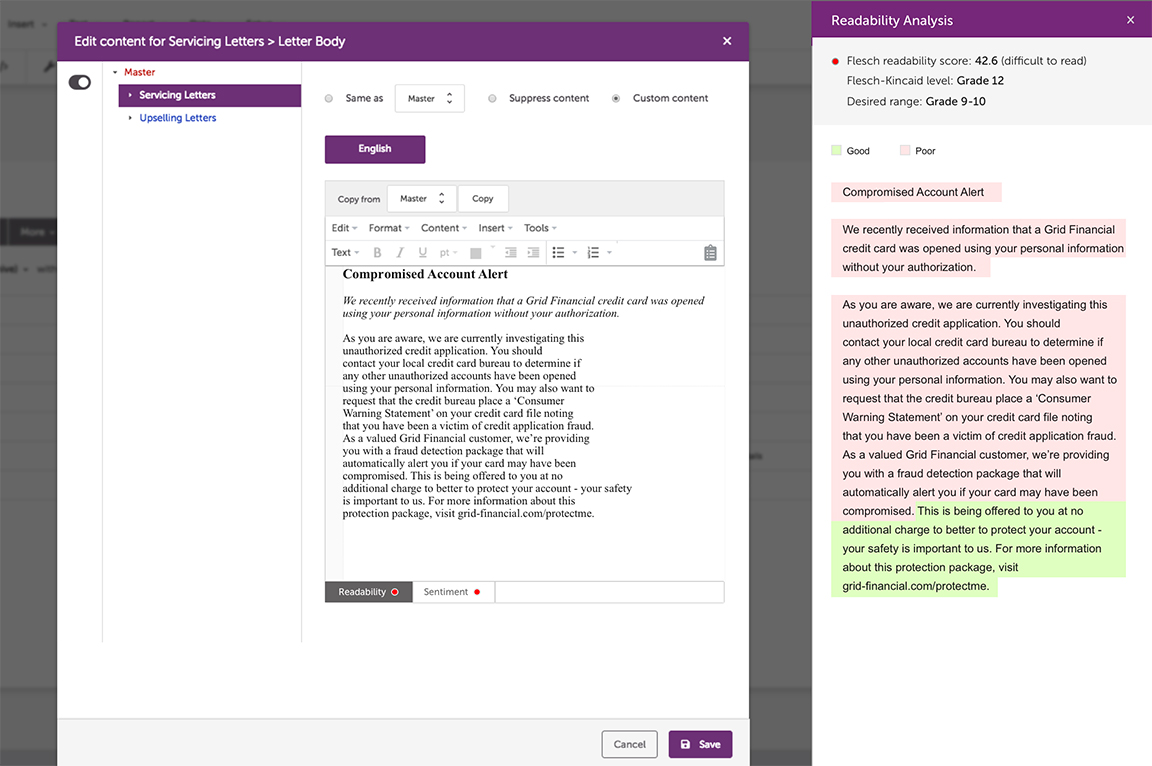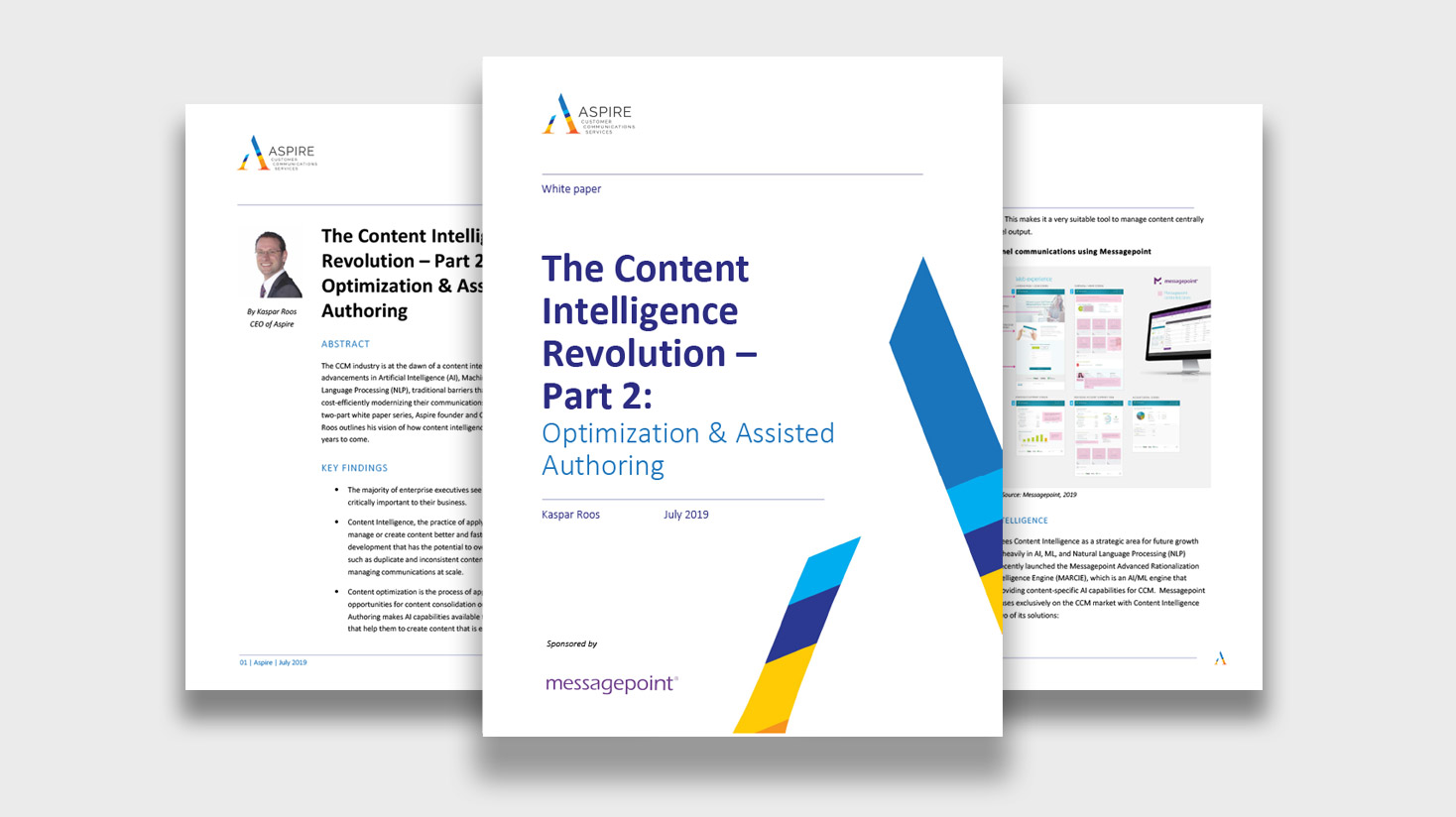Interested in seeing a demo?
Fill out the following information (please ensure you provide some detail on the problem you are looking to solve or the Messagepoint product you are interested in).

No matter the industry, when it comes to customer-facing content, improving customer satisfaction means prioritizing readability—or the ease with which readers can understand written text. Great readability comes from the use of simpler words, plain language and paragraphs that are easier to digest.
The pay-off for organizations that pay attention to readability can be substantial. In 2017, Forrester established the correlation between clear customer communications and increasing revenue by hundreds of millions of dollars. In contrast, customers that are confused by communications will call your support line for clarification, or worse, leave your brand for others they see as easier to deal with.
Communications that are simple and easy to understand give the impression that the brand has nothing to hide, and therefore help build trust. To improve your readability in your communications, start by analyzing what you’re doing now that confuses customers. Then take steps to help employees adopt plain language and stick to it consistently.
Look closely at elements like:
Modern Customer Communications Management (CCM) software solutions can help measure the reading level of your content before it goes out to customers. Messagepoint does this through its Content Intelligence capabilities which automatically assess the reading level of your content using the Flesch-Kincaid test.
In 1975, J. Peter Kincaid developed the Flesch-Kincaid readability formula to help the U.S. Army assess reading difficulty of manuals. Today, it’s used in many industries to ensure written communications are at the right reading comprehension levels. For example, insurance companies in certain U.S. states write policies at a ninth-grade reading level or below.
He created two tests: the Flesch reading ease test and the Flesch-Kincaid test.
The Flesch reading ease test measures the readability of text based on average sentence lengths and syllables. Higher scores mean the written text is more readable or easily digestible. A lower score means your written text is more difficult to read.
The Flesch-Kincaid test presents a score as a U.S. grade level instead of calculating a score like the Flesch reading ease test. This scale generally indicates the number of years of education required to understand a piece of text.
It’s critical that your organization understands your customers. If you serve the general public, most experts advise writing for around an eighth-grade reading level. In certain industries though, such as health, safety or finance, many organizations opt to bring their communications down further still to a fifth- or sixth-grade level. This is done to ensure clarity and understanding. Even if your customers are college graduates, it’s still best practice to limit unnecessary jargon, and consider keeping reading levels at 10th grade or lower.
[/vc_column_text][vc_empty_space height=”30px”][vc_column_text css=”.vc_custom_1556906965547{padding-top: 20px !important;padding-right: 20px !important;padding-bottom: 20px !important;padding-left: 20px !important;background-color: #ebdff4 !important;}”]
The following example illustrates the significant impact of how writing at different grade levels can impact health insurance communications. Messagepoint’s Content Intelligence capabilities were used to automatically rate the grade level using the Flesch-Kincaid test.
It is important to review the changes to make sure our drug coverage will work for you next year. Look in Section 1.6 for information about changes to our drug coverage.[/vc_column_text][vc_empty_space height=”30px”][vc_column_text]
It’s not uncommon to find that you’re writing at too high a grade level. Writing for adults at an elementary school level without coming across as condescending can be harder than you think. The best approach is to use plain language where possible and define technical or industry terms or provide additional context when it’s not.
Taking the following steps can help lower reading levels:
[Source: Plainlanguage.gov]
It’s critical that the content across your customer communications is written at a consistent reading comprehension level. This ensures consistency across the customer experience and prevents erosion of trust. Imagine if your claims documents were vastly more complex than your policy documents or vice versa. Content Intelligence solutions that are embedded as part of a CCM platform can help ensure that this is done not only during a rationalization process on an entire corpus of communications but also on a continuous basis.
In addition, while there are tools out there that can help with readability scoring of a document overall, often it’s just a sentence or piece of legalese that creates the real issue. It’s important to ensure you understand where the real issue lies. The following screenshot from Messagepoint reveals the issue is with a sentence in a message as highlighted in red, which is then easily resolved by the author.

Readability is just one important aspect of your communications that requires constant diligence and attention to ensure consistency and clarity across your customer experience. Automating readability assessments ensures that as edits are made over time, or new content is created, the standards in place are upheld and your desired customer experience remains intact.
Learn more about how Content Intelligence can also help with alignment, brand guidelines, reading comprehension levels and analyzing sentiment.

MARCIE adds powerful Content Intelligence capabilities to Messagepoint’s award-winning CCM platform
Read the brochure
Sentiment analysis, in its simplest terms, is a technique for measuring how customers respond to a product, service,…
Read the Article
The Content Intelligence Revolution – Part 2: Optimization & Assisted Authoring The CCM industry is at the…
Read the whitepaper